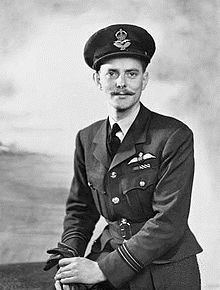Nickname(s) Micky Service/branch Royal Air Force Allegiance United Kingdom Rank Air marshal | Years of service 1940–1975 Name Harold Martin | |
 | ||
Born 27 February 1918
Edgecliff, Australia ( 1918-02-27 ) Commands held Air Member for Personnel
Royal Air Force Germany
No. 38 Group RAF
RAF Nicosia Battles/wars World War II
European theatre
Operation Chastise Awards Knight Commander of the Order of the Bath
Distinguished Service Order & Bar
Distinguished Flying Cross & Two Bars
Air Force Cross Died November 3, 1988, London, United Kingdom Battles and wars European theatre of World War II, Operation Chastise Unit No. 455 Squadron RAAF, No. 50 Squadron RAF, No. 617 Squadron RAF | ||
Other work Adviser, Hawker Siddeley | ||
Air Marshal Sir Harold Brownlow Morgan "Micky" Martin, (27 February 1918 – 3 November 1988) was an Australian bomber pilot and senior commander in the Royal Air Force (RAF). He took part in Operation Chastise, the RAF's "Dambusters" raid in 1943, and was described by journalist Sir Max Hastings as "one of the three great bomber pilots of the war". He rose to become a senior officer in the RAF, commanding RAF Germany and later serving as Air Member for Personnel, a member of the Air Council, the RAF's controlling body.
Contents
Early life
Born on 27 February 1918 in Edgecliff, New South Wales, Martin left Australia for the United Kingdom in 1939. He intended to study medicine at the University of Edinburgh, but instead volunteered to join the Royal Air Force (RAF) on 28 August 1940.
World War II
Martin commenced his operational career with No. 455 Squadron RAAF in October 1941, flying the Handley Page Hampden. In February 1942, he captained the first all-Australian crewed bombing sortie against Germany. Martin soon acquired a reputation for low-level flying in order to avoid anti-aircraft fire and fighters. After 13 operations, he and his crew joined No. 50 Squadron RAF. Flying Hampdens, Avro Manchesters, and finally Avro Lancasters, they completed their tour in October 1942, Martin being awarded the DFC.
Martin's penchant for low flying contributed to his selection in March 1943 for assignment to the newly formed No. 617 Squadron under Wing Commander Guy Gibson. Martin took part in the "Dambusters" raid on the night of 16/17 May 1943. He piloted the Lancaster bomber AJ-P "Popsie" (officially known as AJ-P "Peter") in the first formation, which was assigned to attack the Möhne Dam in Western Germany. Martin's plane was hit by anti-aircraft fire during the attack, but he successfully accomplished the bombing run and returned. He was awarded a DSO for his actions.
Following Gibson's retirement from operations and the immediate loss in action of his successor, Squadron Leader George Holden, Martin assumed temporary command of No. 617 Squadron. Later, under the command of Wing Commander Leonard Cheshire, Martin participated in various pin-point attacks on targets in France, Italy and Germany, often employing the new 12,000 lb (5,443 kg) Tallboy bomb. In February 1944, during an abortive attack on the Antheor Viaduct in the French Riviera, Martin's Lancaster was hit by ground fire, killing the bomb aimer Bob Hay, and causing Martin to force land his crippled aircraft in Sardinia. This was Martin's 49th (and last) heavy bomber operation.
Martin was soon back on operations, however, flying de Havilland Mosquito fighter-bombers with No. 515 Squadron. By late 1944, Martin had flown another 34 operations, where he claimed two aircraft shot down, and three destroyed (and one damaged) on the ground.
Post-war
After the war, Martin attended a course at the RAF Staff College in Haifa and in 1945 joined the headquarters staff of No. 100 Group. He broke the speed record for flying from London to Cape Town completing the 6,717 mile journey in a record time of 21 hours, 31 minutes in a Mosquito for which he won the Oswald Watt Gold Medal and the Britannia Trophy. In 1947 he flew the meteorological Mosquito for the first transatlantic jet crossing in support of No. 54 Squadron's de Havilland Vampires.
Martin was appointed to a succession of staff jobs; Air Attache, Tel Aviv in 1952, Operation Plans Division in 1955, and Group Captain— Electronic Warfare, HQ Signals Command in 1959, before becoming Aide-de-camp to the Queen in 1964. He then served for three years from 1967 to 1970 as Air Officer Commanding No. 38 Group. In 1970 he was appointed Commander-in-Chief RAF Germany and finally, in 1973, Air Member for Personnel.
After retiring from the RAF on 31 October 1974, Martin worked for aircraft manufacturer Hawker Siddeley as an advisor. Sir Harold Martin died at his home in London on 3 November 1988, and is buried at Gunnersbury Cemetery.
